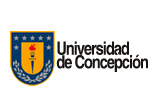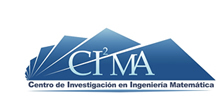News
Undergraduate thesis from UdeC optimizes the processing of this data and was carried out under the CI²MA and the PRECURSOR Group Project
What use can be made of mathematics to study the processes involved in a physical phenomenon such as an earthquake? Is it possible that this discipline helps predict these events? Recently, Iván Navarrete Jara obtained the professional grade of Mathematical Civil Engineer from the Universidad de Concepción, UdeC, after successfully defending undergraduate thesis 'Study of the physical conditions that produce the reactivation of continental faults during the seismic cycle of large earthquakes', in which was directed by Dr. Rodolfo Araya Durán, an academic from the Faculty of Physical and Mathematical Sciences.
“In 2019, I had already selected my topic from memory with Professor Araya and although I was still missing a couple of branches, that was not an impediment to starting the research work. I was always looking for applications of mathematics, I realized that many studied more theoretical areas, but I wanted to study an application, get my hands on something”, Iván explained.
The new engineer explained that “with Professor Araya I had the Finite Elements course, which I really liked, and when I was looking for the topic from memory, it coincided with the fact that he was working on everything that ended up being the Precursor Group Project. With him and Professor Marcos Moreno we put together the project from memory and began to formulate what the guidelines were going to be, where we wanted to aim and we decided to study simulations, test some of the codes that are available to see how it could be implemented, in the context of this project that, as its name indicates, seeks to find some precursor activity to the occurrence of earthquakes, of when the earthquakes are actually going to happen within the seismic cycle, which can take many years”.
Meanwhile, Dr. Araya, also director of the Center for Research in Mathematical Engineering (CI²MA) of the UdeC, alternate director of the PRECURSOR Group Project (ACT-192168) and associate researcher of the Center for Mathematical Modeling, CMM, (FB210003) of the U. de Chile, highlighted that “the enormous work carried out by Iván is the first stone of a future collaboration between our graduates and the geoscience community at the national level. There is much interest among geoscientists in continuing to apply numerical models in order to better understand large-scale geological processes. To this end, Iván Navarrete's work is very remarkable”.
In the context of the development of his thesis, Iván explains “I was able to model the seismic cycle in a better way and obtain a reliable quality code, so that we could simulate without problems a seismic cycle according to certain geometries, which was something that was being sought. and at that time, we tried different codes, and I specialized in one of them, and I made an extra module and also worked within that code”.
“It was difficult at first”, Iván details, “because, as a mathematician, I was not very used to putting my hands in such real physical phenomena and that took me a while because it is not easy to get into the mind of a geophysicist and, then , the next challenge was to make some computational model about that, which involved developing the new code to study and understand earthquakes, without staying in theory, but rather aiming towards a type of applied scientific research”.
A relevant result of this work, details the UdeC engineer, is that “we were able to model the seismic cycle without problems, varying different parameters, in this case within the rupture zone and these results were consistent with what we had previously stated about the seismic cycle. And there were also advances on the design of an adaptive time function, which was one of the most important results during the memory construction process that meant that we were able to reduce the computation times of earthquakes from weeks to hours”.
Navarrete explains that an eventual line of research that could be followed from the results of his report is “to apply them to determine some precursor activity of the seismic cycle within the same simulations and study other types of conditions that allow us, for example, obtain background on this precursor activity and how it could modify the entire cycle”.
However, regarding his projections, he feels motivated to maintain his ties in the academic field. “I am interested in continuing studying, I do not want to lose that contact with the scientific community, but I want to continue making my contributions with the tools I have”.
--
.jpg)
“In this graph, the y-axis is the depth of the fault, and the x is the time step. The different colors characterize the speed at which the fault is moving at that particular depth. Each case corresponds to a different nucleation size. Thus, the darker colors are an indication of blockage in the fault, that is, the necessary tensions are accumulating that will lead to an earthquake, which we can see in a more yellow color. That said, we can also notice that prior to each important event, we can check that there is a slight movement at depths other than the blocking zone. This result may be important to analyze in terms of precursor movement to an earthquake”
.jpg)
“The time steps are adjusted to the needs of the model and that is what we indicate in this graph, in which the x axis is the time step, and the y axis is its size. When we are facing blockages in the fault, the time step does not need to be so small since we are in a process of tension accumulation that can take from decades to hundreds of years. However, every time the fault approaches its rupture state, caused by the large accumulation of stress in it, then the time step is reduced depending on the speed at which the fault is. In this sense, the lowest points characterize the presence of a significant event, and their small value allows us to study moment by moment how the earthquake develops at its most intense moment”


.JPG)